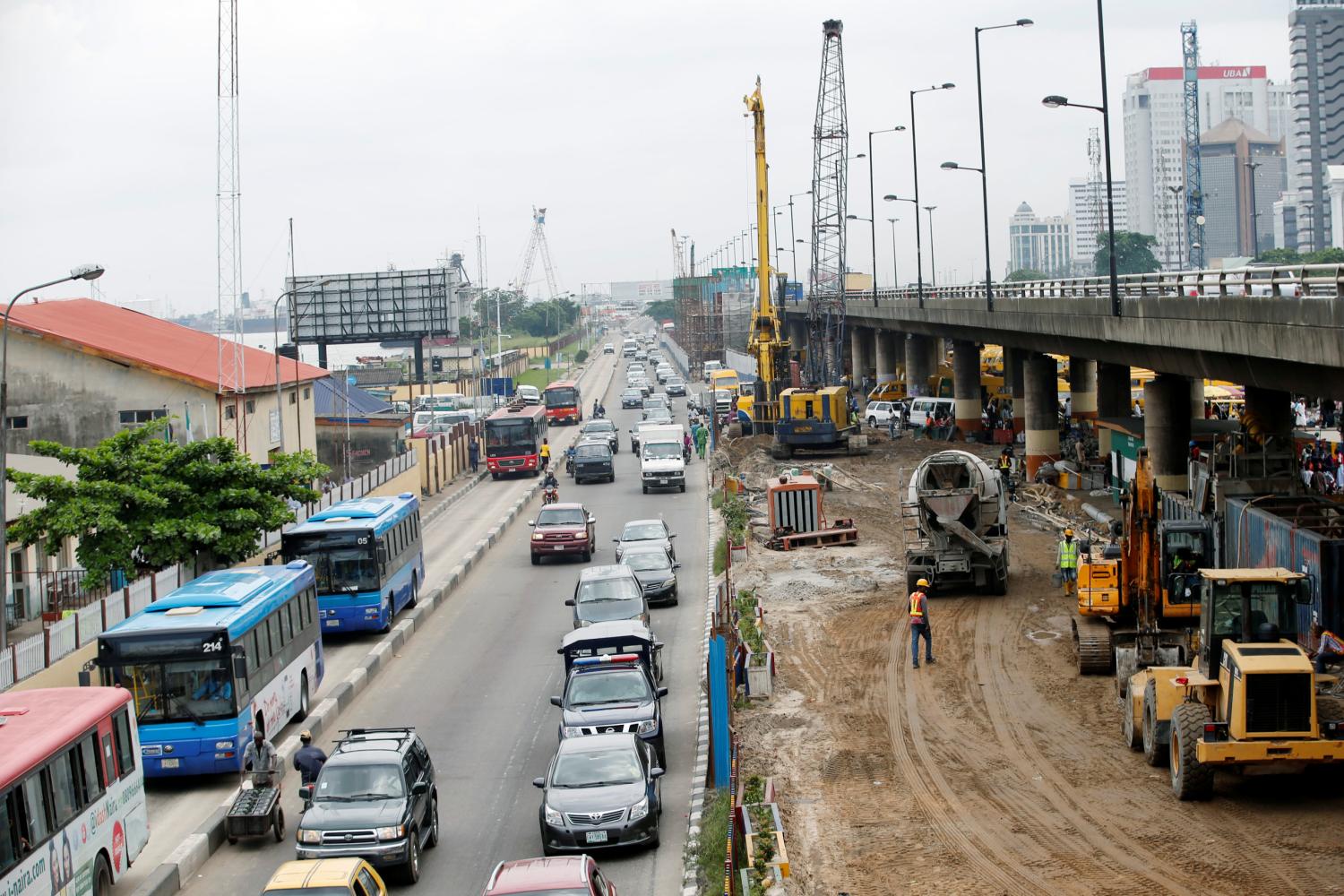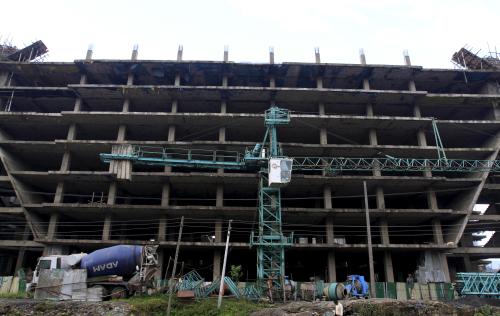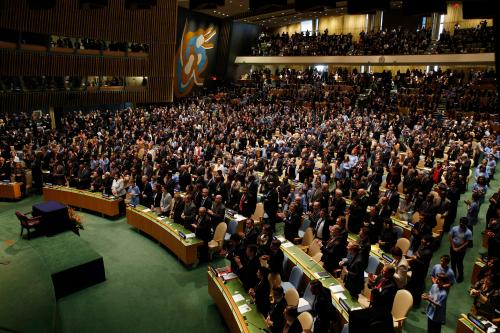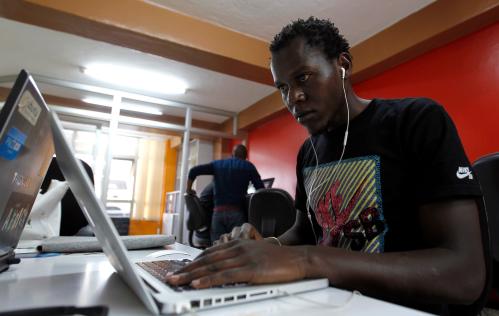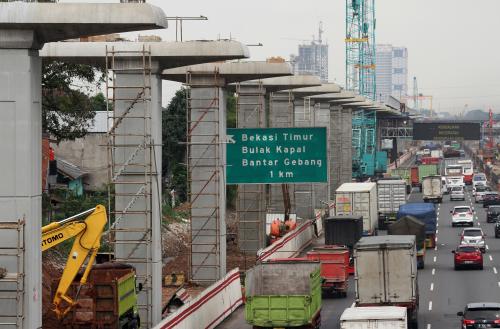There is a consensus among African policymakers that the continent’s economic growth and transformation is significantly constrained by its limited infrastructure. Inadequate infrastructure—including unreliable energy, an ineffective urban-rural road network, and inefficient ports—is one of the largest impediments to Africa’s international competitiveness.
Infrastructure is not only one of the areas in which Africa lags behind the most, but it is also one where the divide between African countries is the largest.1 The infrastructure deficit is particularly high for sub-Saharan African least developed countries (LDCs) even when compared to that of other low-income countries.
Improving African infrastructure can benefit the continent through a number of channels, including better performance in the agriculture sector and increased regional and global trade. Increasing investment in rural infrastructure such as irrigation, roads, and energy can help reduce Africa’s dependence on rain-fed agriculture, improve access to markets for agricultural produce, and increase resilience to climate change. Through better and more affordable information and communication technologies (ICT) infrastructure, farmers can register their land and have access to credit, use land and water more efficiently, obtain weather, crop, and market information, and trace food and animals.
For instance, better ICT cuts across sectors by allowing the rapid and free flow of information. Similarly, more reliable electricity provision can significantly reduce the cost of doing business for all sectors, in particular the manufacturing sector.2 Well-connected infrastructure networks can benefit a broad range of sectors by enabling entrepreneurs to get their goods and services to markets in a secure and timely manner as well as by facilitating the movement of workers. They can also help increase intra-African trade (which currently hovers around 12 percent of total trade) and participation in regional and global value chains.
African policymakers are well aware of the potential for infrastructure to support the continent’s accelerated integration and growth, technological transformation, trade, and development.
African policymakers are well aware of the potential for infrastructure to support the continent’s accelerated integration and growth, technological transformation, trade, and development. The continent’s long-term vision as articulated in Agenda 2063 is that, in about 50 years, African infrastructure will include high-speed railway networks, roads, shipping lines, sea and air transport, as well as well-developed ICT and a digital economy. The vision plans for a Pan-African High Speed Rail network that will connect all the major cities of the continent, with adjacent highways and pipelines for gas, oil, and water, as well as ICT broadband cables and other infrastructure. Infrastructure will be a catalyst for manufacturing, skills development, technology, research, innovation and development, integration and intra-African trade, investment, and tourism. According to Agenda 2063, building world-class infrastructure together with trade facilitation should see intra-African trade growing from less than 12 percent currently to about 50 percent by 2045 and the African share of global trade rising from 2 percent to 12 percent.3
Africa’s focus on infrastructure is not surprising. Infrastructure is the cornerstone of a country’s economic activity, and infrastructure bottlenecks stunt economic growth and increase poverty and inequality. Investing in infrastructure can have three important positive effects on an economy. In the short term, infrastructure spending provides a short-term demand stimulus to an economy and boosts output. In the longer term, infrastructure spending can raise the economy’s productive capacity, thereby its trend growth rate. Moreover, when financed by debt, the return on investment a country gets from increasing infrastructure investment can be large enough for infrastructure projects to pay for themselves.
Attempts to quantify the macroeconomic effects of scaling up infrastructure investment find significant positive effects. Simulations show that in developing economies, increasing the public-investment-to-GDP ratio from 7.0 percent of GDP to 14.0 percent of GDP in about three years and stabilizing it at 9.0 percent of GDP afterwards can substantially increase output by 7.0 percent over the long term (IMF, 2014a).4 To put things in perspective, a recent World Bank forecast for sub-Saharan Africa (SSA) puts real GDP growth at 4.0 percent in 2015 (World Bank, 2015). However, accounting for the continent’s 2.6 percent population growth results in a per capita income growth of only 1.4 percent. As a result, scaling up infrastructure investment in the region could help achieve much needed higher growth.
More and better infrastructure can benefit the economy through a number of channels. Cheaper transport costs can help create new markets and realize the returns to agglomeration, which in turn fosters competition, spurs innovation, lowers prices, and raises productivity, leading to an increase in living standards (Henckel and McKibbin, 2010). Furthermore, transport infrastructure can have a direct effect on economic efficiency of an economy by reducing transport costs and an indirect effect by lowering inventories. As an economy moves up the global value chain, adapting its infrastructure can also help attract foreign investment and contribute to the knowledge transfer, leading to more trade with the rest of the world.
The potential benefits of infrastructure are even larger when network and cross-sectoral impacts and synergies are accounted for. World Bank (2014) stresses, for instance, that investments in a platform of urban services may produce economic returns greater than the sum of each individual investment as infrastructure investments may change land usage, productivity levels, settlement patterns, and property values. Similarly, the World Bank Infrastructure Action Plan FY 2012-2015 flags projects that seek to optimize co-benefits across infrastructure sectors, between infrastructure and environment (green), between infrastructure and social development (inclusive), and spatial benefits (regional) (World Bank, 2011). The Action Plan seeks to identify and prioritize three points of leverage that can unlock a country’s growth and development potential: (i) missing links: infrastructure investments that interconnect two markets/areas such as a bridge within a region or a cross-border power interconnector, international road corridors, or fiber optic links in a region; (ii) bottlenecks: investments that unlock the volume, cost, and quality of economic activity such as a law on competition that unlocks the potential of private sector investments, or a source of clean water that unlocks women’s time to participate in economic activity; and (iii) ripple effects such as an ICT-application that generates data on sector performance with spillover effects in sector accountability and governance, a regional power project that has ripple effects beyond the host country, or a rural infrastructure package that boosts agricultural productivity with ripple effects on rural income and development.
For countries to reap the benefits of infrastructure investment, however, a number of conditions are needed. The IMF (2014a) finds that the short-term effect of increased investment is higher (i) during periods of economic slack and when interest rates are low; (ii) in countries with a high degree of public investment efficiency where new spending is not wasted and goes to projects with high rates of return; and (iii) when new investment is financed through debt rather than through higher taxes or lower spending.
Closing much of this efficiency gap could substantially increase the economic dividends for public investment.
Recent studies show, however, that public investment spending is particularly wasteful in LDCs. For example, IMF (2015) estimates that about 40 percent of the potential value of public investment is lost to inefficiencies in the investment process in LDCs. In contrast, the efficiency gap is 30 percent for an average of 134 countries and is lower for emerging markets (27 percent) and advanced economies (13 percent). Closing much of this efficiency gap could substantially increase the economic dividends for public investment. LDCs can do so by strengthening the institutions related to the funding, management, and monitoring of project implementation while all countries will benefit from stricter oversight of public-private partnerships and better integration between national strategic planning with capital budgeting. In addition to the efficiency of public investment, the effects of investment on developing economies depend also on the type of financing, the response of the private sector, and the ability of the authorities to implement fiscal adjustment and manage debt (IMF, 2014a).
The shared concern for the infrastructure deficit in Africa has led to a proliferation of initiatives. Among the various multilateral initiatives are the following:
- The New Partnership for Africa’s Development (NEPAD),5 established in 2001 under the African Union (AU), supported the Programme for Infrastructure Development in Africa (PIDA)6 in 2011 as one of its flagship initiatives to identify and assess key cross-border infrastructure investments over the period 2012-2040. In the shorter term, PIDA focuses on its Priority Action Plan (PAP), which includes 51 regional and continental infrastructure projects to be implemented by 2020. These projects are designed to meet Africa’s more immediate regional and continental infrastructure needs. To accelerate the implementation of PIDA, African leaders gave their political impetus to eight regional infrastructure projects under the Presidential Infrastructure Champions Initiative (PICI), which was adopted in 2012. In the same vein, African leaders adopted the Dakar Agenda for Action in June 2014 to leverage public-private partnerships and mobilize financing around 16 infrastructure projects to be realized by 2020.7 Concrete steps have also been taken by the NEPAD Agency to ensure acceleration of infrastructure projects on the continent. For instance the Africa Global Partnership Platform (AGPP), a dialogue platform that acts as an “umbrella” for Africa’s rapidly expanding international partnerships was endorsed by African countries at both the NEPAD Heads of State and Government Committee and the African Union Summit in 2014. The AGPP contributes to a greater coherence of Africa’s international partnerships and serves as a platform for feeding Africa’s interests and perspectives into wider global processes. The NEPAD Agency also established the Continental Business Network (CBN), which is an African Union Heads of State and Government response to facilitate private sector engagement and leadership in important continent-wide infrastructure projects, particularly the regional infrastructure projects under PIDA. The CBN aims to crowd in financing and support for infrastructure projects by creating a platform for collaboration between the public and private sectors. The second CBN High-Level Leader’s Dialogue hosted in May 2016 examined the role of the private sector in de-risking PIDA projects and paved the way for the subsequent launch of the “NEPAD Continental Business Network Report on De-Risking Infrastructure and PIDA Projects in Africa,” (hereafter, “2016 De-Risking Report”).8
- The Regional Infrastructure Development Master Plan (RIDMP) of the Southern Africa Development Community (SADC) of 2012 is anchored on the six pillars of energy, transport, ICT, meteorology, transboundary water resources, and tourism (trans-frontier conservation areas). Its Short-term Action Plan (STAP) 2013-2017 includes projects that are considered ready for implementation during the next five years as well as projects related to capacity building, and regulatory and institutional strengthening. The RIDMP is aligned with PIDA and with the COMESA-EAC-SADC (tripartite) Inter-regional Infrastructure Master Plan.9
- In September 2011, U.N. Secretary-General Ban Ki-moon launched the Sustainable Energy for All initiative to make sustainable energy for all a reality by 2030 by fostering partnerships between governments, business, and civil society. In 2014, the U.N. General Assembly declared the decade 2014‑2024 the Decade of Sustainable Energy for All, underscoring the importance of energy issues for sustainable development.
- The World Bank, in partnership with the African Development Bank (AfDB), developed the Africa Infrastructure Country Diagnostic (AICD) that provides a detailed series of infrastructure investment needs by sub-region in 2011.10 In 2014 the World Bank launched the Global Infrastructure Fund (GIF) as a “platform” for identifying, preparing, and financing large complex infrastructure projects.11 This facility will thus also cover infrastructure financing in Africa.
- Africa50, a recent infrastructure investment platform promoted by the AfDB, aims at accelerating project preparation and financing on the continent. In particular, it seeks to shorten the time between project idea and financial close from a current average of seven years to at most three years. Africa50 held its Constitutive General Assembly in 2015 and 20 African countries, and the AfDB have subscribed for an initial amount of $830 million in share capital.12
- More recently, the New Deal on Energy for Africa put forward by the AfDB seeks to achieve universal access to energy in Africa by 2025. The new deal will be implemented through the Transformative Partnership on Energy for Africa, which is designed to provide a platform to coordinate action among private and public partners and offer innovative financing solutions.13
In addition, traditional bilateral and multilateral development flows to African infrastructure have increased overall and there is a growing amount of traditional (such as from the U.S. Power Africa initiative14 and the EU-Africa Infrastructure Trust Fund15) and non-traditional bilateral flows (from China, Brazil, and India). Finally, there are substantial opportunities from the establishment of the BRICS’ (Brazil, Russia, India, China, and South Africa) New Development Bank (BRICS Bank) and the Asian Infrastructure Investment Bank and the Silk Road Infrastructure Fund.
Building African infrastructure will, however, require substantial financing. A World Bank comprehensive study estimates that sub-Saharan Africa’s infrastructure needs are around $93 billion a year, and estimates are higher when financing needs for North Africa are considered.16 According to the NEPAD Agency, the PIDA Priority Action Plan projects require an estimated $68 billion for implementation until 2020. An additional $300 billion is needed for the rest of the projects until 2040.
This report discusses the particular role of pension funds in financing Africa’s infrastructure. A key message of this report is that there is urgency to act now if the significant potential of African pensions to finance infrastructure development is to be leveraged. While sub-Saharan African countries are in a “demographic sweet spot” as dependency ratios are low, the labor force is rising rapidly, and the impact of aging has not yet hit their pension systems, policymakers need to address existing obstacles to pension funds investment in infrastructure. In North Africa, unsustainable pension schemes together with unfavorable demographic and labor trends also point to the need of reforming pension systems.
Apart from countries in southern Africa such as Botswana, Namibia, and South Africa, and a few others such as Kenya and Nigeria, pension assets as a share of GDP are low as pension funds are relatively small and dominated by often poorly performing pay-as-you-go (PAYG) schemes for public sector employees. Even when pension reform has been implemented, as in Nigeria, and assets are available for investment, governance and regulatory obstacles as well as a dearth of adequate financial instruments limit pension funds’ allocation to infrastructure.
This report suggests a number of policy recommendations to address the obstacles to pension funds investment in infrastructure. First, pension reform driven by strong political leadership and ownership by all stakeholders can help improve the performance of African pension systems and develop pension assets. However, pension reform should be carefully designed so as to learn from the lessons of the mixed results of earlier experiences in Latin America, notably in Chile, as well as in Central and Eastern European countries. Second, improvements to the governance, regulation, and supervision of pension funds can help pension funds invest in infrastructure in a manner consistent with their primary goal of ensuring old-age income security. Third, even when sufficient pension assets are available and asset allocation to infrastructure investments is made, African countries will still need to develop domestic financial and capital market instruments for infrastructure investment. Finally, given the large scale of infrastructure investment, African countries will need to consider the net benefits of complementing domestic pension assets with foreign and multilateral investments through co-financing and innovative policies.
The rest of the paper is organized as follows. Section II reviews the current sources of infrastructure finance in Africa (official development finance, private sector, new and emerging partners, such as China and other emerging development partners, and government finance). Section III reviews the international experience with pension funds investment in infrastructure and discusses the potential for leveraging African pension funds for infrastructure development. Section IV analyzes the obstacles to pension funds investment in infrastructure and some concrete steps taken by the NEPAD Agency while Section V concludes with policy recommendations for African pension fund managers and governments as well as multilateral institutions and bilateral partners.
Download the full report »
-
Footnotes
- See Africa Competitiveness Index (2015).
- See Africa Competitiveness Index (2015).
- African Union (2014). http://agenda2063.au.int/en/sites/default/files/agenda2063_popular_version_05092014_EN.pdf
- Methods using more available data show that for advanced economies, an increase in one percentage point of GDP in investment spending in advanced economies raises the level of GDP by about 0.4 percent in the same year and by 1.5 percent four years after the increase.
- For details of the New Partnership for Africa’s Development (NEPAD) at the African Union (AU), see http://www.nepad.org/ about.
- For details of the Programme for Infrastructure Development in Africa (PIDA) of the African Development Bank, see http://www. afdb.org/en/topics-and-sectors/initiatives-partnerships/programme-for-infrastructure-development-in-africa-pida/.
- The Dakar Agenda for Action: Moving forward Financing for Africa’s Infrastructure, June 2014. See http://www.nepad.org/sites/ default/files/The%20DAKAR%20AGENDA%20FOR%20ACTION_0.pdf
- http://aiswpff.com/wp-content/uploads/2016/07/CBN-RISK-REPORT-THIRD-VERSION-DATED.pdf
- http://www.sadc.int/files/7513/5293/3530/Regional_Infrastructure_Development_Master_Plan_Executive_Summary.pdf
- For details of Africa Infrastructure Country Diagnostic (AICD), see World Bank (2011).
- For details of GIF (World Bank), see http://www.worldbank.org/en/topic/publicprivatepartnerships/brief/global-infrastructurefacility.
- http://www.africa50.com/
- http://www.afdb.org/fileadmin/uploads/afdb/Documents/Generic-Documents/Brochure_New_Deal_2_red.pdf
- https://www.usaid.gov/powerafrica
- http://www.eu-africa-infrastructure-tf.net/
- See Foster and Briceño-Garmendia (Eds.). (2009).

